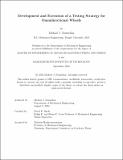Development and Execution of a Testing Strategy for Omnidirectional Wheels
Author(s)
Donnellan, Michael J.
DownloadThesis PDF (170.7Mb)
Advisor
Hardt, David E.
Terms of use
Metadata
Show full item recordAbstract
Omnidirectional wheels enable robots to achieve holonomic motion; however, this often comes at the cost of increased rolling resistance compared to traditional caster wheels. The rolling resistance in omnidirectional wheels is higher than in many other wheels due to several factors including an irregular tread shape, material compliance, and friction in the bushinglike cross rollers during lateral motion. Testing standards exist for characterizing the rolling resistance, compressive strength, and other attributes of commonly used wheels such as caster wheels. However, there are no comprehensive testing standards or research that broadly characterize the performance of omnidirectional wheels. Here, test methods are described for characterizing the load relaxation, stiffness, and rolling resistance of omnidirectional wheels, and the results from these tests are presented. Test apparatuses for static loading and rolling resistance were created. Test results were analyzed to determine important factors for determining the ultimate compressive strength in static loading and the rolling resistance coefficient of an array of omnidirectional wheels, and results indicate wheel manufacturing methods and materials are the most important factors for determining these responses.
Date issued
2024-09Department
Massachusetts Institute of Technology. Department of Mechanical EngineeringPublisher
Massachusetts Institute of Technology